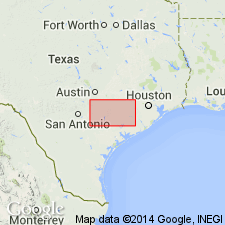
- Usage in publication:
-
- Oakville Sandstone
- Modifications:
-
- Mapped 1:250k
- Dominant lithology:
-
- Sandstone
- Clay
- AAPG geologic province:
-
- Gulf Coast basin
Summary:
Oakville Sandstone. Sandstone and clay; sandstone, medium-grained, calcareous, light yellowish gray to light gray, thick-bedded, some cross-bedding, locally contains fossil wood, quartz and chert pebbles, vertebrate fossils, and reworked Cretaceous invertebrate fossils; clay, calcareous, yellowish gray; forms cuesta of smoothly rounded hills. Thickness 200 to 500 feet. Overlies Catahoula Formation (Miocene); underlies Fleming Formation (Miocene). Age is Miocene.
Mapped in De Witt, Karnes, Gonzales, Lavaca, and Fayette Cos., southeastern TX.
Source: Modified from GNU records (USGS DDS-6; Denver GNULEX).

- Usage in publication:
-
- Oakville Sandstone
- Modifications:
-
- Areal extent
- AAPG geologic province:
-
- Gulf Coast basin
Summary:
Oakville Sandstone. Sandstone and clay; sandstone, medium-grained, calcareous, light yellowish gray to light gray, thick-bedded, some cross-bedding, locally contains fossil wood, quartz and chert gravel, and vertebrate fossils; clay, calcareous, yellowish gray. [Thickness not stated.] Lies above Catahoula Formation and below Fleming Formation. Age is Miocene.
Not separately mapped. Mapped with Fleming Formation [in Duval, Live Oak, Bee, and Karnes Cos., southern TX].
Source: Publication.
For more information, please contact Nancy Stamm, Geologic Names Committee Secretary.
Asterisk (*) indicates published by U.S. Geological Survey authors.
"No current usage" (†) implies that a name has been abandoned or has fallen into disuse. Former usage and, if known, replacement name given in parentheses ( ).
Slash (/) indicates name conflicts with nomenclatural guidelines (CSN, 1933; ACSN, 1961, 1970; NACSN, 1983, 2005, 2021). May be explained within brackets ([ ]).

